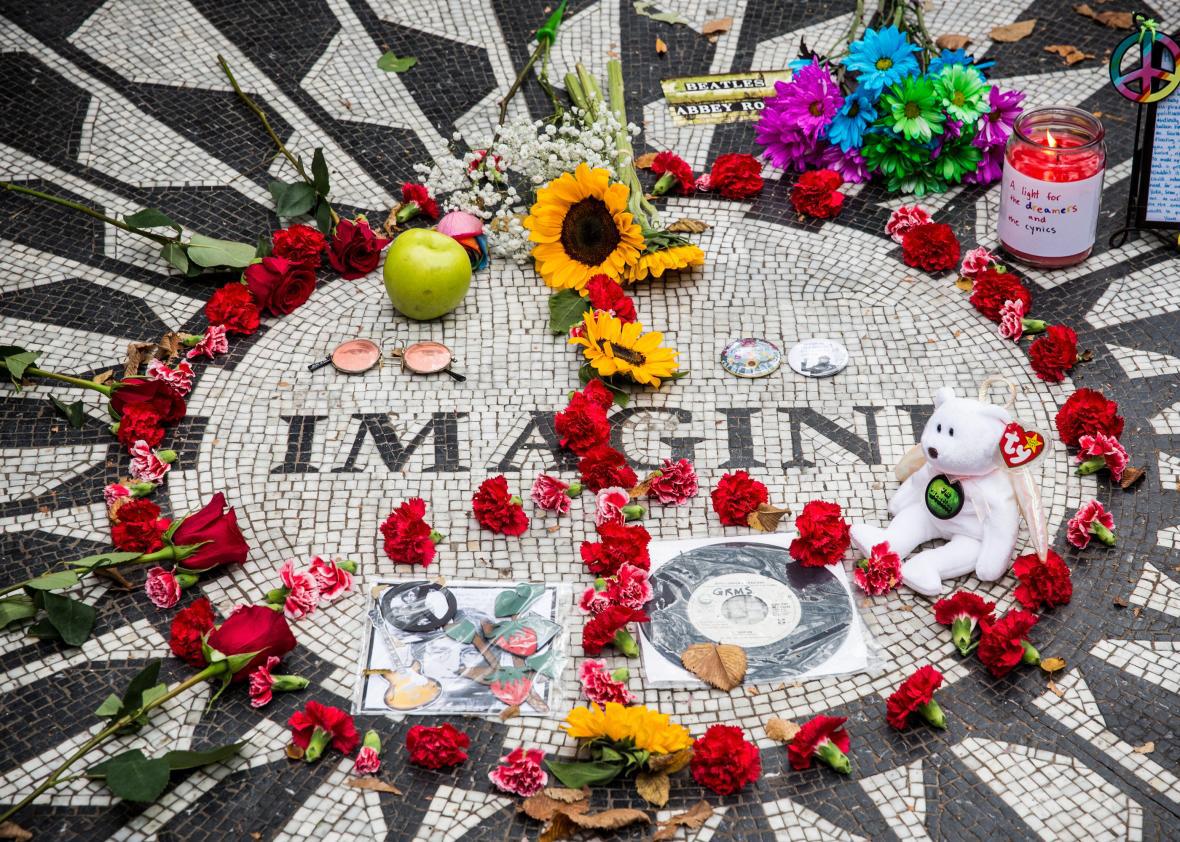When disaster strikes, musicians respond the way they know best: with song. As composer Leonard Bernstein said three days after John F. Kennedy was assassinated, “This will be our reply to violence: to make music more intensely, more beautifully, more devotedly than ever before.” And as the dust of a violent tragedy settles, you’re likely to hear one tune in particular: the contemplative strains of John Lennon’s 1971 “Imagine,” which reached No. 3 in the UK when it was first released and sailed to No. 1 after Lennon’s murder in 1980. On Saturday, Coldplay opened their L.A. concert with “Imagine” in tribute to the victims of the terrorist attacks in Paris. (The band had planned to unveil new material from their upcoming album, but ended up performing an acoustic set of older songs out of respect.) That same night, a man lugged his grand piano to the street outside the Bataclan—the site of the deadliest shootings—and delivered an instrumental version of Lennon’s hit to quiet applause and the flash of iPhone cameras.
These latest covers extend a long tradition of reaching for “Imagine” in the wake of terrible world events. The ritual arguably began on Dec. 9, 1980, when Queen covered the song at the Wembley Arena, one day after Lennon died. Stevie Wonder played it during the closing ceremony of the 1996 Summer Olympics to honor lives lost in the Centennial Olympic Park bombing. Neil Young brought it out for the 9/11 Tribute to Heroes concert. (Curiously, the song also appeared on the Clear Channel memorandum, a list of “lyrically questionable” titles that radio stations were discouraged from playing after the planes struck the towers.) In 2004, Madonna joined the ranks of “Imagine”-eers when she reinterpreted Lennon’s ballad at an aid concert for victims of the Indian Ocean tsunami.
It’s not surprising that musicians turn to this particular work in the aftershocks of tragedy. For one thing, “Imagine” is a song that musicians continually turn to, period: The Broadcast Media Inc. found it to be one of the most covered songs of the 20th century. Its simple, versatile structure has seduced and inspired hundreds of artists, among them Lady Gaga, Emeli Sande, Etta James, Davie Bowie, Pink, Eva Cassidy, and The Persuasions. Even Bill Clinton, backed up by a choir of Israeli and Palestinian children, “Imagine”-ed at Shimon Peres’ 80th birthday celebration (though at one point he forgot the words). What’s more, the lyrics adorn (to randomly select some surfaces) T-shirts, coffee mugs, an infinitely subdividing number of Tumblr and Pinterest pages, a not inconsiderable array of body parts, and a Zazzle dog sweater. “Imagine” has become nearly as ubiquitous as imagination itself.
But it returns to us most bittersweetly when something bad happens, when we are casting about for answers and consolation. The writer John Blaney called “Imagine” a “humanistic paean for the people,” a kind of secular prayer. Rolling Stone described it as “22 lines of graceful, plain-spoken faith in the power of a world, united in purpose, to repair and change itself.” Except that its faith is not absolute. Though Lennon imagines nothing less radical than the toppling of all religious, economic, and social institutions, his vision is wistful and unfulfilled; he’s dreaming, not doing. “I hope someday you’ll join us,” he sings: This is the least coercive call-to-action in the history of revolutions. “Imagine” belongs to the tradition of hymns or spirituals that visualize a glorious afterlife without prophesizing any immediate end to suffering on earth.
That tentativeness is part of what makes the song so appealing in the days after a tragedy. No one who has just watched footage of families mourning their loved ones in the wake of a terrorist attack is ready to swallow a dose of unalloyed affirmation. The song seems veined with the sad understanding that its own dream is too simple—a fact echoed in a piano accompaniment as gentle as a rocking chair, a melody as modest as a lullaby. “Imagine” is set in C major, the plainest and least complicated key, with no sharps or flats. After a few measures in the base tonality, it shifts to a plaintive major seventh chord that allows a tiny bit of E minor into the tonic; then it lifts to the familiar IV (no surprises here, beyond that flick of chromaticism guiding you home). The progression wanders further from center as the lyrics intensify and Lennon’s vision gains force and clarity: “Imagine all the people / living for today.” For a moment, the singer is swept up in what he’s conjured. Then he comes back to reality as the tension leaks slowly from the harmonies: “You may say I’m a dreamer.”
In other words, “Imagine” is a brilliant marriage of form and idea. But the song also derives considerable power from its historical context. Lennon, shot down before his time, reminds us that the universe can run ramshod over idealistic people. That knowledge makes “Imagine”’s plea for peace and brotherhood all the more poignant. On the other hand, the fact that the song persists, even though Lennon is gone, speaks to the enduring strength of his fantasy. If “Imagine” captures the fragility of our hope after a violent or destructive event, it also reveals its tenacity.
